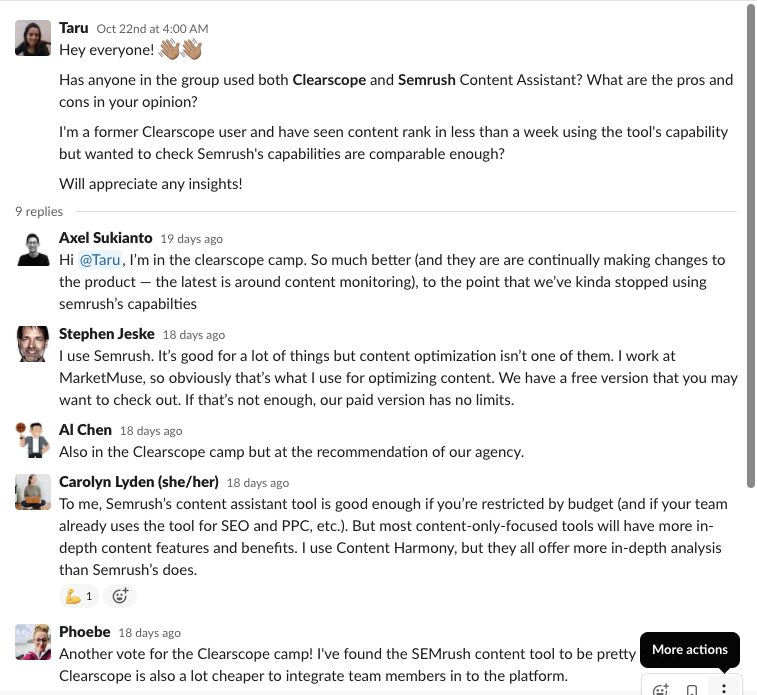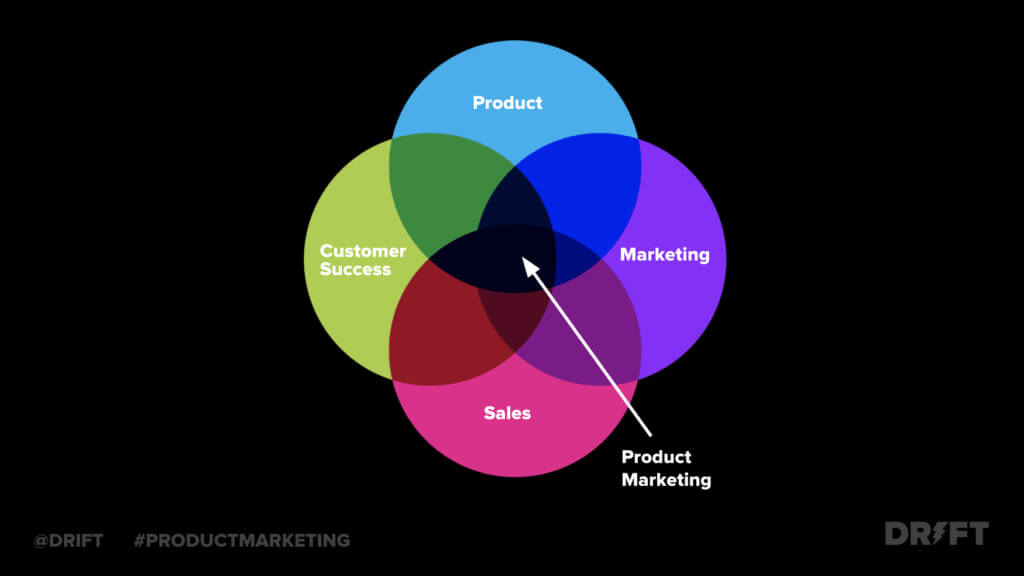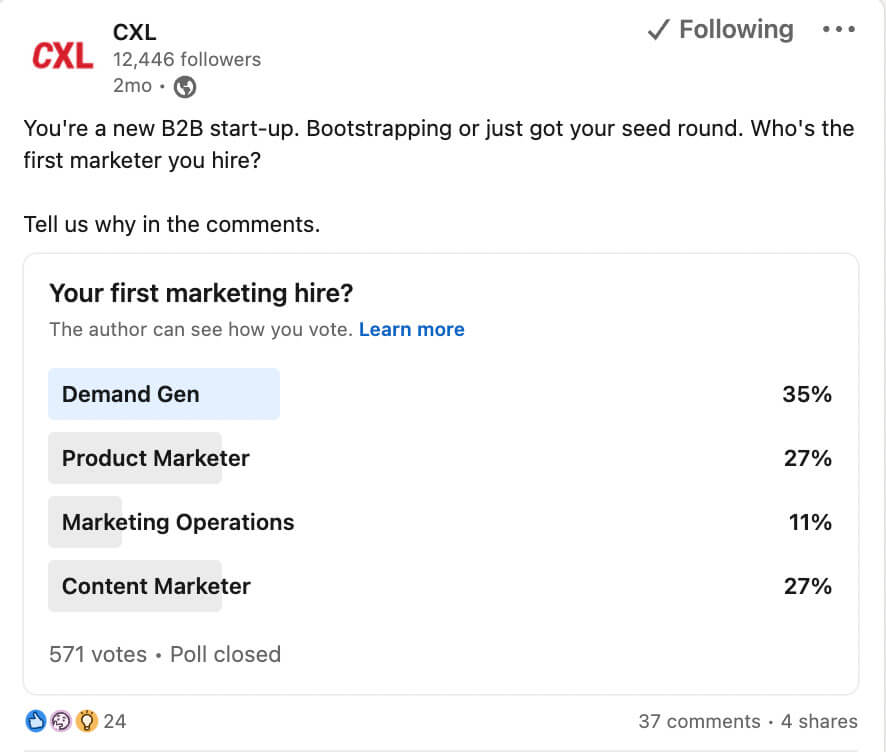Daniel J. Murphy is known for elevating SaaS startups to new levels of success. He helped Privy become one of the fastest-growing companies in the U.S., established HubSpot’s customer review program, and grew Drift’s marketing team eightfold in two years.
He helped grow these companies as a product marketing manager.
The product marketing manager (PMM) is responsible for creating and executing the product marketing strategy. It’s a vital hire for companies competing in saturated markets—which means most companies today.
In this article, you will learn the core responsibilities of the product marketing manager, plus the skills and attributes that make a truly great PMM.
Table of contents
What does a product marketing manager do?
Product marketing managers are right in the middle between Product, Marketing and Sales teams. Their goal is to show (and market) the benefits of the product, and direct the marketing strategy for it.
Product marketing manager vs. product manager: what’s the difference?
Though product marketing managers and product managers work closely together, they are very distinct roles.
The product manager is the voice and direction of a product within an organization. Their role is internal.
They lead the product team, oversee the entire product lifecycle, and determine the strategic vision for product development.
They’re responsible for:
- Defining the “why,” “what,” and “when” of product development;
- Working with the engineering team to deliver on the “how to use it” aspect;
- Determining the long-term product vision;
- Setting goals and initiatives to achieve that vision;
- Working with the marketing team (often the product marketing manager) to understand user needs.
The product marketing manager, on the other hand, voices the benefits of the product to the outside world.
They lead a team of product marketers, establish a go-to-market strategy, conduct customer research, and define messaging and positioning for the product.
The product marketing manager job description involves:
- Communicating the “why,” “what,” and “when” of the product to potential buyers, as well as to internal teams (often the sales team);
- Launching the product;
- Announcing new product features;
- Expanding reach and identifying new audiences;
- Creating product positioning and messaging that resonates with the brand’s target audience.
While both are focused heavily on the user, the product manager is more interested in understanding what users want to achieve when using the product.
The product marketing manager is more interested in understanding the buyer characteristics of the user and discovering how to communicate the value of the product in order to convert them.
The two roles work closely together, as the insights gleaned during their respective research processes are valuable across both disciplines.
For example, a product marketing manager might uncover customer insights that pivot the product team’s direction.
Similarly, the product manager may significantly change features that will require the marketing team to tweak or pivot their message.
The route to becoming a product marketing manager can start from many other roles, such as sales, marketing, or product development. Along the way, a PMM will need to pick up key skills in strategy, messaging, market research, and more.
Carving out a career as a product marketing manager
Product marketing is a discipline that seeks to communicate the “why,” “what,” and “when” of a product’s features to potential customers as well as internal stakeholders (such as salespeople and developers).
The “why” answers the customer’s question: “Why should I care about these product features?”
The “what” answers: “What features are the most important to me?” and “What do I want to achieve when using the product?”
The “when” answers: “When do I need these features?”
The product marketing role sits at the intersection of marketing, sales, and product teams and focuses primarily on anticipating and answering customer questions and objections.
Where the brand marketer answers the objection “Why should I buy from your organization?”, the product marketer caters to the question: “Why should I choose your product?”
While product marketing is one of the most crucial marketing functions, it’s also one of the least understood, meaning product marketing can look vastly different across different organizations.
Across the board, though, product marketing’s main focus areas are:
- Positioning;
- Messaging (and voice of customer);
- Pricing;
- Packaging;
- Segmentation;
- Product launches.
Within the team of product marketers, the PMM owns the entire strategy, delegates tasks and resources, hires and organizes the team structure, and is ultimately responsible for the success of the organization’s product marketing efforts.
Responsibilities of the successful product marketing manager
Product marketing managers are responsible for positioning and messaging across the product lifecycle.
This can be divided into three core segments, approximating the stages of the marketing funnel:
- Acquisition;
- Engagement;
- Conversion and Retention.
Acquisition: Capture customer attention
Acquisition efforts center on gaining the attention of potential customers, making the market aware that your product exists.
Common tactics include blogs and long-form content, search engine optimization, PPC advertising, and social media marketing strategies.
Product marketing managers working on acquisition should focus on understanding what captures customer attention.
ClickUp’s product marketing team might have discovered that social proof is a key driver for conversions among their target audience of agile developers.
They used their ad copy space to include big brand names. By doing so, they borrow the big brands’ influence in an effort to persuade users to sign up for their free trial.
Engagement: Develop an audience of advocates
Engagement efforts focus on developing a community of superfans.
Activities include in-person and virtual events, special offers, email marketing campaigns, social media group engagement, and the creation and distribution of mid-funnel content.
CXL generates engagement from marketers interested in CRO, analytics, and growth by posting industry-specific questions on social media:
CXL creates brand awareness and loyalty by asking thought-provoking questions and getting involved in the comments with expertise and opinion. Brands that engage with their customers build trust by reinforcing their reputation and being accessible.
Conversion and Retention: Encourage a purchasing decision
Conversion and retention efforts are focused on turning leads into paying customers and keeping paying customers around.
Conversion tactics should focus on reducing friction.
Take Cozy Earth, retailer of premium bamboo bedding. Having performed extensive customer research to understand prospects’ main buying objections, they came to understand that price is a barrier to purchase.
Cozy Earth removes the friction from this decision by providing a 100-night trial, where customers can return their purchase within 100 days if they’re unconvinced the product is right for them.
Aside from product marketing tasks, product marketing managers also undertake a variety of management and leadership duties.
Defining both long- and short-term visions
Product marketing managers are responsible for developing a marketing team’s long-term vision, defining goals, key metrics, and tactics used to achieve these objectives.
They’ll work closely with the product manager to understand the future and direction of new product developments and tailor their marketing strategy to its evolution.
This aspect of the PMM’s job description is fairly research-heavy.
It involves defining:
- The target customer. What are the primary customer needs? What challenges do they face? Where can they be found? How do they use our product?
- Product naming. Based on an understanding of the target audience, and typically developed using focus group research.
- Product positioning. What category does the product fall into? Who is the product for? What benefits does the product offer, and how do they contribute to customer success?
The PMM is also responsible for clearly communicating their product marketing strategy motivations to their product marketing team.
The ideal way to do this is to involve your team in building the vision itself. When everyone in your team has contributed to the product marketing strategy, and owns specific duties (e.g., social media research, framing messaging, etc.), they’re more committed to the goal you’ve defined.
Building a successful team
A large aspect of the product marketing manager role is building and leading a team that you trust to deliver on the larger mission.
An easy mistake to make is to look for marketers who are just like you, with all of the skillsets and attributes you bring to the table.
Great PMMs take the opposite approach. Look for gaps in your own skillset and then fill those gaps with complementary hires with strengths in other disciplines.
Consider this list of skills and attributes that are important to product marketing success:
- Market research;
- Audience analysis;
- Copywriting;
- Creativity;
- Problem-solving;
- Communication skills;
- Digital advertising;
- Strategic thinking;
- Prioritization;
- Storytelling;
- Email marketing;
- Roadmapping;
- Project management;
- Content marketing.
Perform an honest assessment of yourself as a marketer, and rank your ability in each discipline.
The areas where you’re not so strong tell you where you should hire first.
Team building, motivation, and conflict management
Leading your product marketing team to success involves people management, team motivation, and conflict resolution skills.
New leaders should consider Harvard’s 6 styles of leadership, to understand which persona they most strongly embody.
Keeping your team motivated will be an ongoing challenge and will require careful attention to individual drivers.
Motivation isn’t cheerleading. It isn’t a five-minute stand-up each morning where you give an inspiring speech to rev up the team.
Team motivation means connecting with the individuals in your team on a personal level and understanding their larger goals outside of fulfilling their duties (e.g., who wants to be a PMM one day, and how can you support that?).
Personal development can be a powerful motivator. According to a Gallup workplace study, development opportunities are a top employment factor for Millennials.
Focus on individual strengths, and provide opportunities to develop these skills to their maximal potential.
Conflict is inevitable in the workplace, particularly as teams grow larger and more diverse opinions enter the group.
Some conflict can be positive, if handled well. Employees should be encouraged to debate alternative viewpoints and solutions, provided the discussion intends to identify the ideal solution rather than to levy a personal attack.
Even with this expectation in place, quality conversations can deteriorate. The product market manager’s responsibility is to defuse and resolve such conflicts.
The Society for Human Resource Management has a number of great resources for understanding how to manage conflict in the workplace.
Marketing manager or individual contributor?
For many, the step up from product marketing to marketing management seems to be the logical career progression, but these are very different roles.
Working as a marketing manager is much more about building and developing a team and guiding them to execute on strategies, rather than focusing on specific tactics and execution itself.
For this reason, many choose to remain individual contributors.
Your decision to move into a management role should not be based on the feeling that you should keep climbing the career ladder.
What’s the average product marketing manager salary?
The product marketing manager salary is an average of $112k per year in the U.S., but your decision to become one should be based more on a desire for personal growth and development.
Consider your strengths and what you want your role to look like when weighing up whether or not to take on product marketing manager responsibilities.
Some attributes to consider:
- Your willingness to give up doing the work yourself and trust others to complete it;
- Your inclination towards other people;
- Your ability to focus on long-term goals;
- Your desire to seek out and grow peoples’ unique strengths.
Many great leaders have been introverts (Lincoln, Eleanor Roosevelt, Gandhi), and you’ll learn conflict resolution skills along the way as part of your own development.
Great product marketing managers wear many hats
PMMs can take products from innovation to scale. Because they’re involved at every stage, they need to be great at a lot of skills—and know when to pivot.
Here are some of the top traits for successful PMMs.
Be passionate about, use, and understand your products
The best product marketing examples exist when PMMs use their products regularly and have a deep understanding of all features and uses.
As a user, you’ll understand the value your product brings, and will have a better insight into how to communicate these benefits to other users.
You can also spot opportunities for improvement and feed them back to the product team.
Be the voice of your customer
Talk to your customers often. Make them feel like you’re listening to their feedback, and seek to understand the motivations behind what they’re saying.
Watch and interpret their actions. How do they use your product? How do they talk about it in public? What questions are they asking in support logs, or in social media communities?
Take this discussion about Clearscope and Semrush. Product marketers from both platforms can gain a ton of insights from chat between users like this.

The more you actively listen to and engage with your users, the better you’ll understand how they’ll react to product updates and how to communicate with new markets. You can also feed insights gathered here back to the product team.
Identify who your biggest influencers are, and engage with them directly. Keep them happy, and you’ll be able to leverage their influence among others.
Keep an eye on your competitors
Your product does not exist in a vacuum; prospective customers are evaluating all possible options. Current users also likely have an eye on the market and can be persuaded to jump ship.
Watch how your competitors are marketing their products, and how their audience reacts to their messaging. Use their products and identify areas where they outperform your product.
Use brand tracking tools to track consumer sentiment and market changes. Knowing the value their product brings (and how this compares to yours), as well as understanding their marketing strategies, will allow you to better position your product and identify new angles.
Don’t attempt to market to everyone
Your goal should be to grow a community of superfans—users who are profoundly influenced by your product—not just to attract more consumers of any kind.
Research and understand the markets and demographics your product is best designed for, and position your product messaging to speak directly to them.
If you attempt to market to everyone, those who convert will likely become disappointed when the product isn’t exactly what they wanted.
Be prepared to react fast when things go wrong
Be agile and react quickly when something goes wrong with a product launch.
Daniel J. Murphy, the expert PMM in the beginning of this article, lists four mistakes he often sees product marketers make in a product launch:
“1) Waiting for something new from the product team to launch vs. designing a launch around a strategic company goal
2) Going to market with messaging that matches what the product team gave them vs. coming up with messaging for your target customer
3) Trying to do too many things (emails, content, channels, etc.) in the launch vs. focusing on the few things that will get you to your launch goal
4) Not setting an attainable short-term launch goal and then delivering on a brilliant launch but not being able to explain the success of it to your management team.” [Via Sharebird]
Work to quickly find the cause of negative response, and address it directly by communicating with customers. Feed information back to the product team and release product updates as soon as possible.
Get creative with your marketing
Task risks. Try new things. Trust your hunches.
The best product marketing managers incorporate a growth marketing approach, designing experiments, analyzing results, doubling down on what worked, and continuing to experiment.
Understand the opportune moment for a product launch
New products don’t have to be perfect, final-form iterations to be ready for launch.
If you continue chasing down “perfect,” you might never launch at all.
Understand what your minimum viable product looks like, design a new product launch marketing plan, and release.
Build time into your schedule to help the product team make adjustments based on customer feedback, and let your user base guide the product roadmap.
Reassess product performance on a regular basis
Don’t neglect products you’ve already launched, even if your team focuses on developing new, exciting products.
Regularly reassess your entire product range and how each product is performing. What metrics have dropped? What changes have occurred in that vertical since launch? Is your product still an attractive proposition?
Consider retiring weaker products as your range grows, keeping your product line strong and your overall brand proposition positive.
Meet often with product stakeholders
Great product marketing managers meet regularly with company stakeholders, from the ideation phase right through to launch and post-launch.
They work with stakeholders across all departments and recognize that each can provide valuable insights.
Sales team members can communicate common customer pain points and the most influential selling points.
The customer service team can provide insights into areas where the product doesn’t perform as well.
Product developers can explain technical limitations (or areas where your product performs better than competitors).
Market internally
Powerful product marketing managers don’t just market to customers; they market internally to the company’s employees.
Get employees excited about the products they’re selling, supporting, or working on. Make them feel like they’re part of the mission. Get them to truly understand the problems your customers face, and how your product transforms their daily lives by solving that problem.
Conclusion
Product marketing management is a discipline where you can thrive if you’re passionate about building a team of successful marketers and owning a product’s positioning and messaging from start to finish.
The position requires a fair degree of people management skills and leadership capabilities. Some prefer to remain individual contributors and focus on developing their product marketing skills over leadership abilities.
Whichever direction you choose, the most powerful way to drive your career forward is to constantly upskill.
To learn more about product marketing management and practice from leading practitioners, take CXL’s Product Marketing Minidegree.










